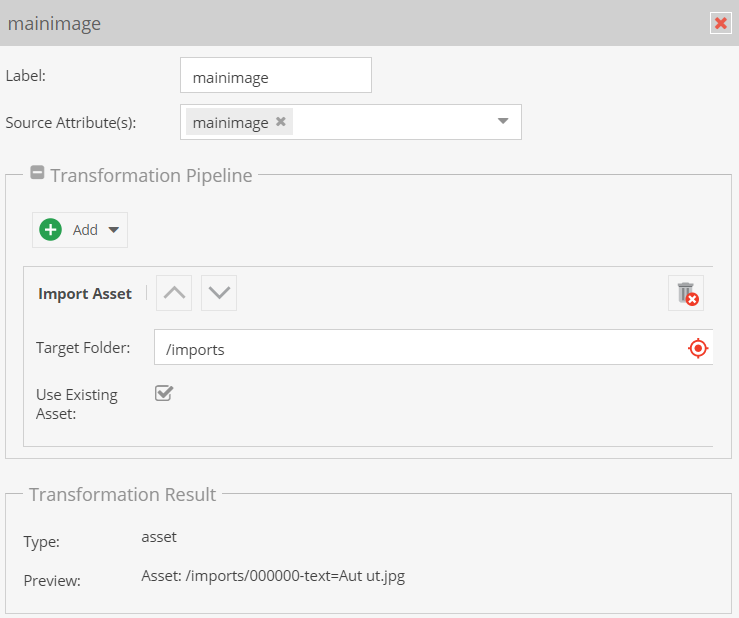Transformation Pipeline
The transformation pipeline takes the data read from source data based on the
Source Attributes setting and transforms it to a necessary target format
with one or multiple operators.
The transformation result panels shows information about the current resulting type of the transformation and - if a preview file is uploaded - also a preview based on the currently active data record of the preview panel.
The result type is also important for the Data Target setting as it defines available options there.
Operators
Operators transform the input data to a desired output format. Every operator expects certain input formats and delivers certain an output format.
There are two groups of operators
- Standard Operators: Do some real processing and transformation with the input data.
- Factory Operators: Prepare data for a certain necessary result type, e.g. convert a
date to a
Carbon\Dateso it can be assigned to a date field etc. Their name is usually prefixed withAs.
List of available Operators
- As Array: Converts data to an array, if not already.
- As Boolean: Converts data to a boolean.
- As Date: Converts data to a date, format definition necessary.
- As Gallery: Packs a single asset, or an asset array to a gallery.
- As Image Advanced: Packs a single asset to an image advanced.
- As Input Quantity Value: Converts an array to a quantity value object for input quanitity value, expects first item in array to be value, second item in array to be unit id.
- As Input Quantity Value Array: Same like
As Input Quantity Value, but for arrays of values. Expects an array with sub-arrays where first item to be value and second item to be unit id each and results in an array of quantity value objects. - As Numeric: Converts data to a numeric by using
floatval. - As Quantity Value: Converts an array to a quantity value object for quanitity value, expects first item in array to be value, second item in array to be unit id.
- As Quantity Value Array: Same like
As Quantity Value, but for arrays of values. Expects an array with sub-arrays where first item to be value and second item to be unit id each and results in an array of quantity value objects. - As Geopoint: Expects an array, where the first item reflects the value for the latitude attribute and the second item reflects the value for the longitude attribute.
- As Geobounds: Expects an array, where the first and second item reflect the values for the northeastern latitude and longitude, third and fourth item reflect the values for the southwestern latitude and longitude respectively.
- As Geopolygon: Expects an array with a variable amount of items. Whereas first and second item reflect latitude and longitude for the first point, third and fourth item for the second point and so on.
- As Geopolyline: Same as
As Geopolygon. - As Color: Converts an array(R,G,B,A) or a hex-string to a color object.
- As Countries: Converts an array of countries into an array of country codes
- Combine: Combines an array to a string with using configuerd
glue. - Explode: Explodes string to array using configured
delimiter. If input is an array, explode is done on every array item recursively. Depending ifDo not flatten sub arraysis set, the operator results in one flat array with all items, or in an array with sub arrays. - Flatten Array: Converts one array with potential sub arrays into one flat array with all items and sub items in one level.
- HTML Decode: Applies
html_entity_decodeto input data. - Import Asset: Expects a URL as input, downloads data via
file_get_contentsand stores it as new asset in configured target folder. File name is extracted from URL viabasename. If asset with same name already exists, either it is reused (whenUse Existing Assetactivated), or a new asset with suffix in file name is generated. - Load Asset: Loads existing asset based on path or id
- Load DataObject: Loads existing data object based on id, path or specific attribute. With specific attribute it is possible to find the object with a partial match of the attribute value (e.g. data value
%foo%would find an object with attribute valuebarfoobar) - Reduce Array KeyValue Pairs: Reduces a flat array
['k1', 'v1', 'k2', 'v2']to key-value pair array['k1' => 'v1', 'k2' => 'v2']. - Trim: Removes leading and/or tailing white spaces from string.
- Static Text: Adds a static text to the value - either prepends or appends it.
- Conditional Conversion: String values are converted to other string values (e.g. '0' to '1' or 'csv-value' to 'object-value'). Multiple conversions can be configured by separating the values with pipe symbol ('|') (e.g. '0|1|2' to 'some|other|values'). An asterisk can be used as a wildcard (e.g. '0|*' to 'no value|default' where '0' will be converted to 'no value' and all other values to 'default').
What Operators are NOT supposed to do:
- Complex statistical calculations: you possibly get an idea like that you can explode string to array and then calculate some average value, but it is wrong place to do it. Please keep the import peformance light.
- Assign data to data object fields: One import is updating fields of one Data Object. If you need to update another one then please create one more import.
